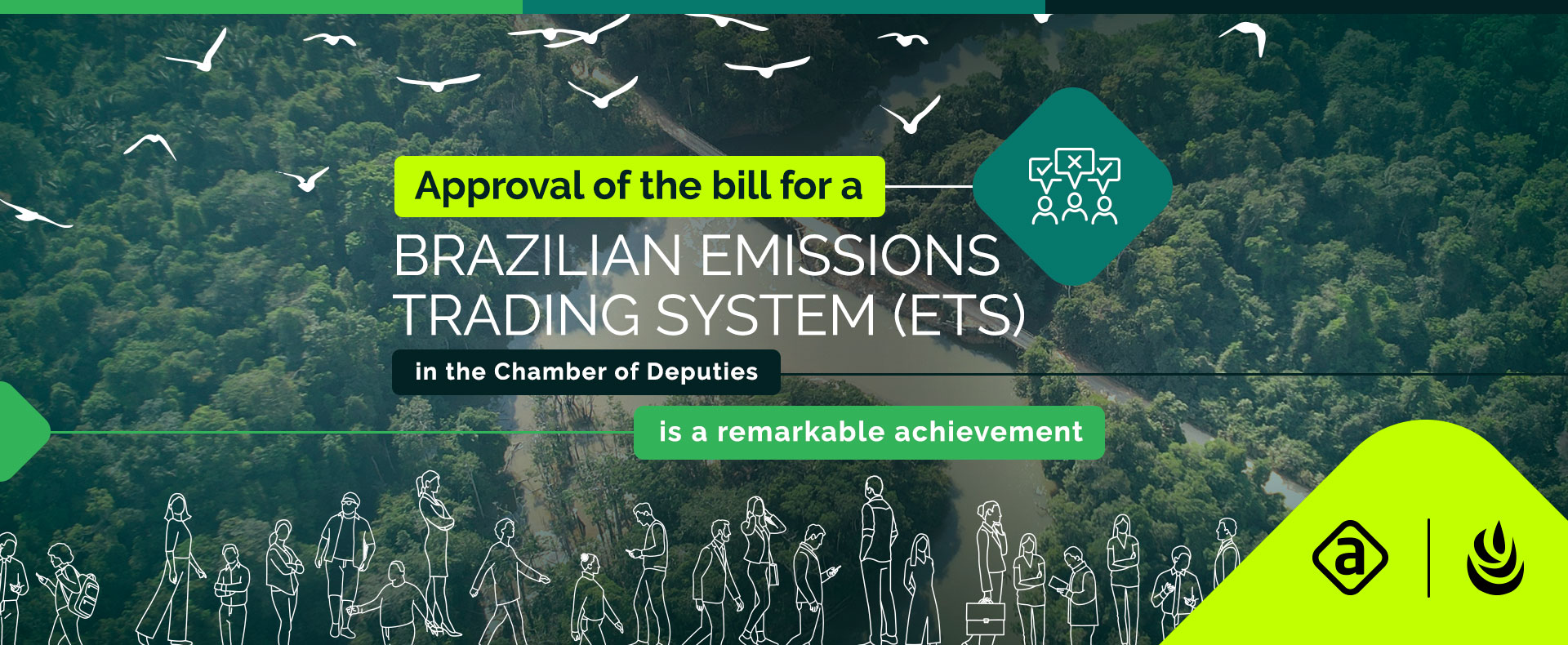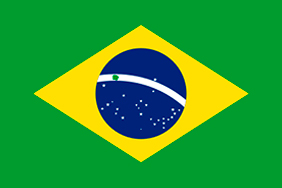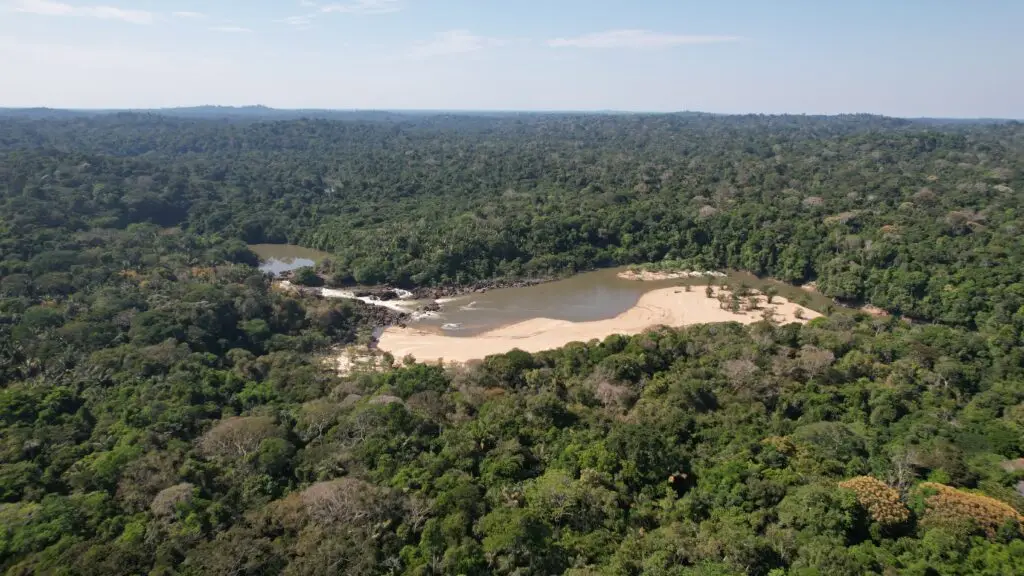
🌳 IN A REMARKABLE ACHIEVEMENT, THE BRAZILIAN CHAMBER OF DEPUTIES APPROVED A BILL TO ESTABLISH A NATIONAL ETS.
In a year marked by the worsening of the global climate crisis, in which we experienced extreme temperatures, droughts in unprecedented places and tragic floods, yesterday, Brazil experienced a historic moment within its Chamber of Deputies when the deputies approved a bill proposal to establish an emissions trading system (ETS) for the country. There were 299 votes in favor of the 404 parliamentarians present. This means that 73.76% of the deputies voted in favor of this major step for the decarbonization of its industries.
Since the sanction of the National Climate Change Policy in 2009, there has been a legal provision in Brazil for the creation of a regulated carbon market. It’s been a long 14 years of waiting, a period in which we missed great opportunities to position ourselves at the forefront of the world as a leading country in creating innovative solutions that drive economic growth in a sustainable manner. It’s worth remembering that, in 2009, the European ETS, the first regulated market of its kind in the world, was only 3 years old and was still in its infancy. Today it trades more than 754 billion Euros in its primary and secondary markets, generating € 42 billion annually of taxes for the bloc’s countries.
But why is having a regulated national carbon market so important for Brazil?
First, it is always important to highlight the differences between an ETS and the Voluntary Carbon Market. In an ETS, the State establishes a Greenhouse Gas (GHG) emission limit within the productive sector, enabling the eventual trading of deficits and surpluses of emissions between each other. On the other hand, the voluntary market is characterized by an environment in which people, companies and organizations neutralize their GHG emissions through purchases of carbon credits.
According to the proposed regulation, companies that emit more than 10 thousand tons of carbon dioxide equivalent – CO2E1 per year will be required to establish a plan to monitor their emissions, developing a periodic report, while companies above 25 thousand tons of CO2E per year, in addition to reporting and monitoring, they will need to reconcile their emissions through emissions licenses distributed free of charge or at a cost by the government. It is estimated that there are around 5,000 companies in Brazil that emit more than 25 thousand tons of CO2E. Thus, the Brazilian Regulated Market, when implemented, will be the largest carbon market in Latin America.
Secondly, by creating an emissions license trading system, in which it is possible to transact emissions quotas between companies that have exceeded their respective GHG limits with companies that have managed to decarbonize their production processes, we enable carbon pricing to encourage the competitiveness of the Brazilian industry and its innovation.
As in Brazil more than 50% of greenhouse gas emissions are the result of deforestation, forest degradation and land use change, the proposed law is in the right way establishing interoperability between voluntary and regulated markets, through the possibility for companies to offset part of their emissions through the acquisition of Verified Emissions Reduction or Removal Certificates – CRVE, which will be voluntary carbon credits converted for commercialization in the regulated market, after the definition, by the Brazilian State, of which certification bodies and methodologies currently available will be capable of acceptance in this new market.
Other advances in the Brazilian voluntary carbon market in the proposal approved by the Chamber of Deputies:
- Legal certainty on points such as the ownership of credits, in which it was defined that, while the current status for voluntary carbon credit remains, when a carbon credit is transformed into a CRVE, it will be interpreted as a “market asset”)
- Free initiative (including at a state level) in the development of carbon projects
- Rules that prevent double counting of credits and increase the socio-environmental integrity of projects
- Update of tax legislation regarding credits
- Freedom for states to implement their own jurisdictional programs (under the responsibility of the public authorities) for carbon generation, while at the same time there is also the guarantee of the possibility for private properties to exercise their property rights by requesting the exclusion of their respective areas from such programs
- Environmentally appropriate waste disposal and recycling projects can generate carbon credits
- Guaranteeing appropriate benefit sharing for traditional communities and indigenous peoples, in which ARR initiatives will allocate to those communities at least 40% of the carbon credits generated, while REDD+ projects will allocate a minimum of 60%
- Guarantee that those settled in agrarian reform projects have the same rights and duties as indigenous peoples and traditional communities
New additions to the emissions trading system included:
- An allocation of 85% of the resources raised by the regulated market to finance scientific research and technological development activities with the aim of promoting the decarbonization of productive activities
- Entry of motor vehicles as a source of regulated emissions
- Environmentally appropriate waste treatment and final disposal units will be considered based on their transversal potential for mitigating greenhouse gas emissions and will not be subject to the emission limits set out in the law when they are proven to adopt systems and technologies to neutralize such emissions.
- Double appeal level for possible application of fines for non-compliance with emissions reconciliation.
Lastly, it is important to note that there are still several steps necessary to implement a Brazilian ETS. The proposal will now be sent back to the Federal Senate, which has already approved material that was used as the basis for the bill approved by the Chamber of Deputies. This should speed up the legislative process, but as highlighted, the bill has suffered several modifications that need to be discussed. Finally, if the bill is sanctioned, the proposed timeline of implementation is five years.
Biofílica Ambipar Environment will continue to share our technical expertise with the Brazilian parliament, the Federal government, civil society and, principally, our clients, to engage in their business decarbonization.
[1] CO2E is a metric measure used to compare emissions of various greenhouse gases based on global warming potential relative to carbon dioxide (CO2). For example, the global warming potential of methane gas is 21 times greater than the potential of carbon dioxide (CO2). So, we say that the CO2 equivalent of methane is equal to 21.





